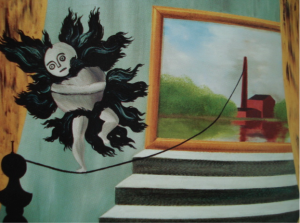I must admit, I don’t remember ever hearing the word metalepsis before. And when I google its meaning, I then have to google the meaning of the words used to define it. ‘Trope’ and ‘extradiagetic’ aren’t part of my day-to-day vocabulary – though they might have been if I’d stuck with language and literature instead of veering off towards educational technology.
This definition ‘any intrusion by the extradiegetic narrator or narratee into the diegetic universe (or by diegetic characters into a metadiegetic universe, etc.), or the inverse […]’ is fairly typical. The diegetic universe is the fictional universe – Narnia and Discworld are clear examples, but most works of art and fiction present their own world. The extradiegetic universe is one that is different from the fictional one. So metalepsis takes place when a story’s author intrudes their comments within the story, or when the artist’s hand suddenly appears in a comic strip in The Beano transgressing the boundary between the narrative world and the physical world.
This Magritte painting is an example of taking it further – the movement between fictional worlds and different realities.
At the ‘Creating Second Lives’ conference, Astrid Ensslin began to explore the connections of metalepsis with the conference theme of ‘Blurring the Boundaries’.
Lots of ideas – too many for me to note down during the presentation. They include ‘participatory metalepsis’such as cosplay and fan fiction, and the ‘avatar as a metaleptic vehicle’ that takes us into a different world.
Two themes emerging for me – one about paratexts (the texts that arise around digital media, such as walkthroughs, cheat guides and fan fiction) and about ‘parapractices’ (a term I’ve just invented to cover cosplay — I’m sure there are more examples). Also the theme of the wish to move between the worlds – to bring our avatar into real life, or to move with our avatar into the virtual world (see Liberate Your Avatar for an example of this).
